
Eugonobapta is a monotypic moth genus in the family Geometridae described by Warren in 1894. Its only species, Eugonobapta nivosaria, the snowy geometer, was first described by Achille Guenée in 1857. It is found in North America from Manitoba to New Brunswick, south to North Carolina and Tennessee.

Eumacaria is a monotypic moth genus in the family Geometridae described by Packard in 1873. Its only species, Eumacaria madopata, the brown-bordered geometer moth, was first described by Achille Guenée in 1857. It is found in North America, where it has been recorded from British Columbia, northern Washington, southern Saskatchewan, from Maine to Florida, South Dakota, North Dakota, Nebraska, Wyoming, Idaho, Colorado and New Mexico. The habitat consists of orchards and shrublands. The species is listed as threatened in Connecticut.

Euphyia is a genus of moths in the family Geometridae erected by Jacob Hübner in 1825.
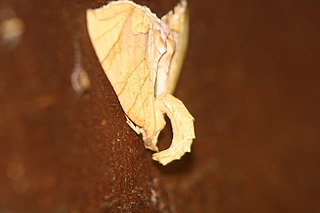
Eulithis gracilineata, the greater grapevine looper, is a moth of the family Geometridae. The species was first described by Achille Guenée in 1858. It is found from eastern Canada south to Florida. It has also been collected west to Saskatchewan and central Alberta, where it is rare.
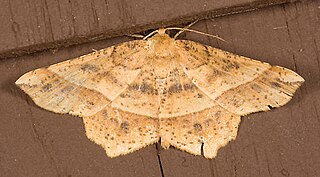
Euchlaena tigrinaria, the mottled euchlaena, is a moth of the family Geometridae. The species was first described by Achille Guenée in 1857. It is found from New Brunswick to Virginia, west to Texas, Utah and Oregon, north to British Columbia.
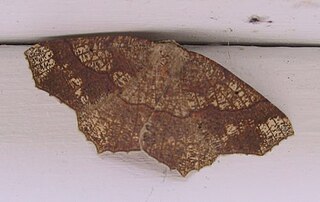
Besma quercivoraria, the oak besma, is a moth of the family Geometridae. The species was first described by Achille Guenée in 1857. It is found across southern Canada and all of the United States except California.

Euphyia unangulata, the sharp-angled carpet, is a moth of the family Geometridae. It shares its common name with the similarly coloured Neoarctic, Euphyia intermediata.

Scopula inductata, the soft-lined wave, is a moth of the family Geometridae. It was described by Achille Guenée in 1857. It is found in North America, from Newfoundland to the coast of British Columbia, north to the Northwest Territories, south to Alabama and Utah.

Lithostege griseata, the grey carpet, is a moth of the family Geometridae. The species was first described by Michael Denis and Ignaz Schiffermüller in 1775. It is found in most of Europe, from Great Britain and the Iberian Peninsula to the Ural Mountains and further east to central Asia and Transcaucasia, Asia Minor and the Near East.
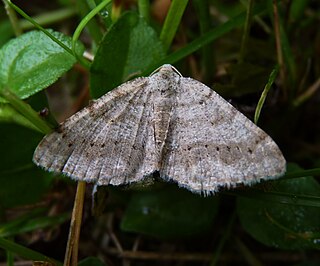
Digrammia ocellinata, the faint-spotted angle or locust looper, is a moth of the family Geometridae. The species was first described by Achille Guenée in 1857. It is found in the eastern United States, Quebec and Ontario.

Pleuroprucha insulsaria, the common tan wave moth, is a moth of the family Geometridae. The species was first described by Achille Guenée in 1857. It is found in eastern North America, from Nova Scotia to Florida, west to Texas and Colorado and north to Ontario. It ranges south through Mexico and Central America into South America and has been recorded as far south as the Galápagos Islands. It has also been recorded from the West Indies, including Jamaica.
Phrygionis paradoxata, the jeweled satyr moth or silvery phrygionis, is a moth of the family Geometridae. The species was first described by Achille Guenée in 1858. It is found in North America, including Florida. It is also known from the Bahamas, Cuba, Jamaica, Hispaniola, the Dominican Republic and Dominica.
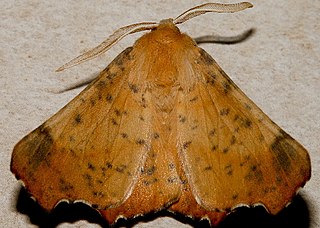
Ennomos magnaria, the maple spanworm moth, notched wing moth, notched-wing geometer or notch-wing moth, is a moth of the family Geometridae. The species was first described by Achille Guenée in 1858. It is found from coast to coast in southern Canada and the northern United States, south in the east to Florida and Louisiana and in the west to California.

Chytonix palliatricula, the cloaked marvel moth, is a moth of the family Noctuidae. The species was first described by Achille Guenée in 1852. It is found in North America, where it has been recorded from southern Canada to the Gulf Coast. The range extends west into the Great Plains to Nebraska and Oklahoma in the south and Alberta and British Columbia in the north. It is also found in Mexico, Guatemala and Panama.

Dichorda iridaria, the showy emerald moth, is a moth of the family Geometridae. The species was first described by Achille Guenée in 1857. It is found in North America, where it has been recorded from Alabama, Arkansas, Florida, Georgia, Illinois, Indiana, Iowa, Kentucky, Maryland, Massachusetts, Mississippi, New Hampshire, New Jersey, New York, North Carolina, Ohio, Oklahoma, Ontario, Pennsylvania, Quebec, South Carolina, Tennessee, Texas, Virginia, West Virginia and Wisconsin.
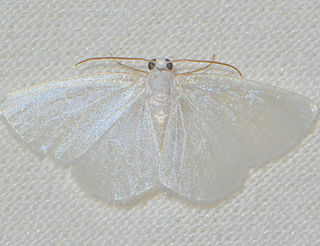
Lomographa vestaliata, the white spring moth, is a moth in the family Geometridae. The species was first described by Achille Guenée in 1857. Adults are diurnal and on wing in spring.

Doryodes spadaria, the dull doryodes moth, is a moth of the family Erebidae. The species was first described by Achille Guenée in 1857. It is found in North America, where it has been recorded from coastal Florida, Georgia, North Carolina, South Carolina and Texas. The habitat consists of salt marshes.

Eudeilinia herminiata, the northern eudeilinia, is a moth in the family Drepanidae. It was described by Achille Guenée in 1857. It is found in North America, where it has been recorded from British Columbia to Newfoundland, south to Florida and west to Texas. The habitat consists of deciduous woods and wood edges.
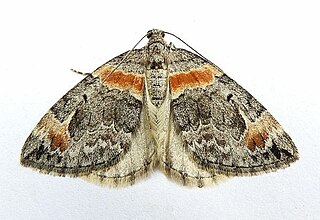
Dysstroma hersiliata, the orange-barred carpet moth, is a species of geometrid moth in the family Geometridae. It is found in North America.


















